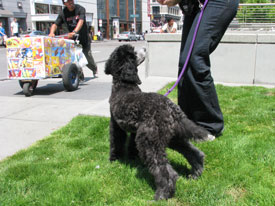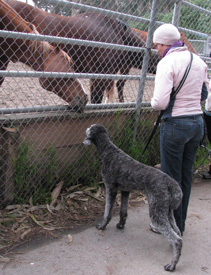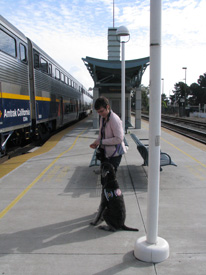Fluency training—don't leave home without it
Fact: Dogs don't generalize well.
Fact: Dogs are very good at discriminating.
"My dog can sit, come, target, give eye contact, walk politely on leash, (insert any other behavior here) well at home, or even in the training center, but the behavior breaks down or the response is otherwise unsatisfying when I begin taking the behavior on the road and into the real world."

Dedicate yourself to fluency training if you want reliable and immediate cue responses regardless of environmental distractions. The various components of fluency are described below; start by examining each behavior to find out which aspects of fluency apply. Develop a training plan to address those aspects individually.
Only work on one aspect of fluency within a given training session. Why? Let's say that you are learning to play the banjo, and you are also learning to speak Japanese. As new tasks, they each require a fair bit of concentration and mental energy. Would it be easier to practice the banjo today and concentrate on the Japanese lessons at another time, or would you like to learn the Japanese alphabet and the banjo at the same time? Eventually, you'll be able to sing a song in Japanese while playing the banjo. But, both banjo playing and Japanese speaking will require significant practice—separately—before it's possible to do them both skillfully and simultaneously.
Introduce two (or eventually more) aspects of fluency into a given training session only when each aspect is meeting your criteria individually. Teach your dog the way you would want to learn, and allow separate training opportunities for each new criterion or aspect of fluency. Don't increase criteria unless your dog is achieving 80% success at the current criteria level. If your dog is performing at less than 50% reliability at the current criterion, break the training down into smaller steps and lower criteria to ensure a high rate of reinforcement.
What do fluent behaviors look like?
There are a number of components of fluency that may need to be shaped when polishing a specific behavior. I like to divide the components into three groups. The first group is "the 3 Ds"-distraction, duration, and distance. The second group is "PaLS training"—Precision and Latency, Speed.
The final component of fluency, and the culmination of good training, is stimulus control. The four corners of stimulus control are described in more detail below, but are:
- The dog does the behavior immediately upon perceiving the cue
- The dog does not offer the behavior without being cued (doesn't "throw" the behavior at you during training sessions)
- The dog does not offer the behavior in response to some other cue
- The dog does not offer any other behavior in response to the cue
Not all behaviors (or all trainers, for that matter) require proofing to a high level of fluency. You may not want to put behaviors like eye contact under stimulus control, for example. Training stationary behavior responses (sits and downs, for example) from a distance is different from training moving behaviors (heeling or loose-leash walking). Moving behaviors are trained for distance and duration at the same time.
Those D words
Distractions are everywhere! If you want your dog to respond to cues regardless of the distractions in the environment, manage the environment effectively throughout the training. Be realistic; don't ask the dog for behavior that he can't perform in an environment that exceeds his current level of training.
Start small. A handler movement (i.e., wagging a finger, tilting the head) is a good general distraction with which to start. Move on to bigger body movements (jumping up and down, spinning in a circle) until those are also reliable. Other ideas for distractions to introduce include tactile distractions (holding position for touching, petting, grooming), bouncing tennis balls, remote-control cars, kids, cats, food on the ground, balloons tied to the mailbox, the television, and music. Scents can be huge distractions for dogs.

The surface the dog is training on can function as a distraction, too. If a dog is used to performing a behavior on a hardwood floor, he may not respond to the cue the first time on grass, or pavement, on a fluffy bed, or in the snow. Weather is another distraction—will your dog respond to cues if it's raining?
If the dog performs reliably in the bathroom, practice in every other room of the house. Practice in the car. How about in a box, with a fox, with a mouse, in a house, here or there, proofing, proofing everywhere! (Dr. Seuss knew something about proofing, I tell you!)
Duration is next. Some dogs think "sit" means, "put butt on floor, receive click, receive treat, pop back up into stand or lay down." It's important to remember that the click ends the behavior, but don't forget that every behavior that occurs between the click and the delivery of the reinforcer is reinforced. In this case, that would include popping up.
Practice reinforcement delivery. Feeding while the dog is in position is a critical bit of information for the dog. You can reinforce in one position and then offer a hand target to reset the dog for another opportunity to receive both the cue and reinforcement for a correct response. I like the "300-Peck method" for building duration. (For more information on the "300-Peck" method, check out Aidan Bindoff's great blog post and article on the topic.)
You can use the "300-Peck method" to build distance as well. Initially, you may need to use management tools like tethers and baby gates to keep your dog from running up to you to respond to the cue. Most dogs think cues mean "do x behavior directly in front of my handler," and for these dogs the natural response is to try to come in close to you when responding to the cue. Tethers and baby gates are great for "kick-starting" distance responses. Manners Minders, which allow you to reinforce the dog from a distance, and stationary targets are also great for teaching distance behaviors.
PaLS training: Precision and Latency, Speed
For PaLS training, the first step is defining the baseline. The technique used to establish baseline and goal behavior for precision is different from the technique used to establish baseline and goal behavior of low latency and high speed.
Precision is the final, polished look of the goal behavior. Your perfect vision of a retrieve may be to have the dog grab the object in the center, hold it between the canine teeth without wobbling, and then deliver to hand without mouthing. Your current retrieve may be wobbly and "chompy." To start, describe both your current behavior and your goal behavior in as much detail as possible; videotaping your sessions may help with this.

I liken precision training to being a GPS for your dog; know the starting location, the ending location, and every turn and corner you need to take to get there before you start the trip. You may need a number of training plans to get there, depending on the complexity of the behavior, and you may need to shape the position of multiple body parts separately.
Remember that you are looking for 80% reliability before increasing criteria. Remember, too, to break the behavior down into smaller pieces when the rate of reinforcement sinks too low to keep your dog happily engaged in the session and actively offering behavior.
The technique for establishing a baseline and raising criteria is so similar for latency and speed, that it is best to discuss them together.
Latency is the amount of time that passes between delivery of the cue and when the dog initiates his response. Speed is the amount of time that passes between the beginning of the dog's response and the completion of the response. Living with my dog Monte has taught me all about high latency (and, coincidentally, low speed). I would ask for a sit, and before his butt started to lower to the ground I had time to call my mother, write this article, and teach one or two classes! And, while his butt began to lower but before it actually hit the floor, I could get a couple loads of laundry done, at least!
Trainers often recommend "clicking only the fastest sits." The problem many trainers run into is developing a framework for comparison—in order to be able to judge which sits are the "fastest," you need to establish baseline latency. A friend with a timer, and pen and paper or a video tape can be helpful.
Remember that to establish a baseline for latency you should start the timer when the cue is given, and "stop the clock" when the dog initiates the beginning of the behavior (clicking the initiation of the behavior). To establish a baseline for speed, start the timer when the dog initiates the beginning of the behavior and stop when the dog completes the behavior (clicking the completion of the behavior).
Do 10 trials and write down the appropriate time for each trial. After 10 trials, establish an average response time—your baseline. Do another 10 trials, now only clicking responses that come in under the baseline. Take a quick break to play with your dog, walk around the block, or give some belly scratches. When you resume training, take a new baseline. Has the time improved? Look at the last recorded baseline. Is your dog responding to the new criteria you've set at least 80% of the time?
Continue to establish new baselines, reinforcing responses that come at or under the current criteria, until you reach the goal behavior. Every time you establish a new baseline, take note of the lowest number. If you get a response at .5 seconds, for example, you know that can be your eventual goal, as your dog is capable of doing the behavior that quickly.
For a dog that loves to play, using reinforcers like tug, fetch, chase, quick hand targets, or jumping (Mokie loves to jump to nose target my hand) can introduce movement and momentum into a training session, Exciting reinforcers elicit more rapid responses—"If I do the behavior faster, I earn the tug faster!"
Stimulus control
Essentially, stimulus control means that within the context of a training session the dog offers the behavior when it perceives the cue and does not offer the behavior in the absence of the cue. For example, your dog will not "lie down" when you say "sit." It also means your dog waits for cues rather than anticipating them. Games that mix well-proofed cues in random order are fun and good mental workouts for dogs, and teach the dog that your cues will be unpredictable. After adding a cue, don't reinforce un-cued offerings of the behavior during training sessions. (It is still wise to reinforce nice sits while greeting guests, going to his bed or crate to relax on his own, voluntarily "checking in," i.e. offering eye contact or an un-cued recall in a highly distracting environment like a playgroup, etc.) You may not want to put all behaviors under stimulus control; only you can decide what you to train.

Mastering a new language takes time
Wow, this sounds like a lot of work!
It may seem overwhelming to think about all of these aspects of fluency. Take a deep breath—and be patient with yourself and your dog. Remember, there is a big difference between knowing five or ten Spanish words and being able to speak the language. Fluency is a new language for your dog.
Make training sessions short and fun for everyone. Always end a session on a positive note. Record-keeping is valuable for tracking progress, seeing where the process should be revised or refined, and getting feedback from any trainer(s) you work with regarding training plans.
If you're a careful observer and someone who keeps detailed training records, you'll notice an exciting twofold process: you will become a more skilled and more empathic trainer, while your dog learns to learn!
Feel free to set your own criteria for how reliably, how quickly, how precisely you want your dog to respond. Some people really don't care about how straight or tucked a sit is as long as the dog lowers his rear fairly soon after he is asked.
The first few behaviors you train to fluency will take longer than any subsequent behaviors. Once you have three or more behaviors well-trained to fluency and under stimulus control, you should find all future proofing for fluency speeds up.
For most clients I advise spending ten to fifteen minutes a day training, keeping in mind that most dogs would prefer five three-minute sessions a day to one ten or fifteen-minute session. Even within the context of a 1.5 minute session, you could choose to work on five or more behaviors if you are working on stimulus control.
Frequent fun and short training sessions, well-timed clicks and reinforcement delivery, and clear criteria setting will have you and your dog on the path to proofing success in no time. Get out there with your dog and start clicking for fluency today!



Thank you to Veronica Morris and Ollie!
I'd just like to thank Veronica Morris for letting me use pictures of her Psychiatric Service Dog with this article, and her husband Brad for being the photographer! Great pictures of Ollie!
Casey Lomonaco, KPA CTP, APDT
Rewarding Behaviors Dog Training
Binghamton, New York
www.rewardingbehaviors.com/forum/
Post new comment